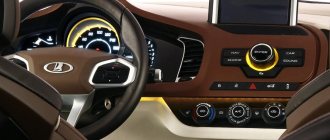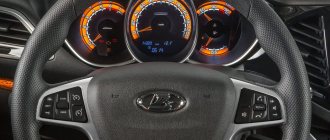Just six months ago, sales of the new Lada Vesta Cross station wagon began. Even at the start of sales, it became known that the model would be successful. The signature color that the new product sported at the very beginning of sales is the Lada Vesta Cross Mars. He managed to appear in advertising, and in numerous test drives, and on television.
The name of the color Mars for the Lada Vesta Cross was taken due to its external resemblance to the surface of the planet Mars.
On the official website LADA.RU the color Mars is described as follows:
The embodiment of passion, the color of dynamics and adventure. Branded enamel, created specifically for LADA Vesta SW, fully reflects the originality of the car.
As practice has shown, this color suits station wagon buyers well. And, to be honest, I didn’t pay enough attention to this color until recently. But when I saw him for the first time, I changed my mind. The Mars color of the Lada Vesta Cross looks very impressive, especially if you look at the car on a sunny day. The car plays with all its colors in the sun. And the depth of color changes from every angle. A very interesting combination. Plus, the black plastic body kit goes well with this shade - it doesn’t catch the eye and doesn’t blend into the body.
↑ Lada Vesta sedan palette
The color scheme of the sedan is made in the following colors:
- crystal white “Glacial”;
- red Lada Vesta sedan “Carnelian”;
- brown "Angkor";
- one of the most popular colors of Lada Vesta is gray-beige “Carthage”;
- green Lada Vesta “Lime” sedan;
- deep blue and unusual “Blues”;
- another color palette of the Lada Vesta sedan is the gray-blue shade “Phantom”;
- metallic gray color Lada Vesta “Pluto”;
- pure black tone “Black Pearl”;
- silver "Platinum".
LadaVestaCross with silver Platinum color
This is a metallic shade, so it shimmers beautifully in the sun. Less dirty than white, the silver tint visually enlarges the car, making it even larger.
Perfectly suitable for both men and women. On the one hand, it looks solid and strict, on the other, a warm and gentle shimmer makes the car delightful.
The application technology and increased thickness of the paint coating by 25% allow the manufacturer to guarantee 6 years of corrosion-free driving.
The partially galvanized metal frame undergoes sandblasting and degreasing at the first stage.
Sequence of body painting operations:
- in a closed chamber, a layer of primer is applied by automatic spraying;
- drying in a drying chamber;
- application of enamel coating;
- drying;
- surface varnishing;
- control examination;
- manual correction of defects.
After this, the finished body enters the assembly line.
The wide color palette of the Lada Vesta is not only the development and merit of the management of the automobile concern, it is also the painting features. Thus, the process of painting the body of a Lada Vesta car model is carried out using modern technologies. At the very beginning, a thin layer of high-quality primer is applied to the galvanized metal surface - applying it using cataphoresis. This allows you to protect the metal from corrosion and destruction in the future.
Signs of a faulty relay regulator
The first, main and at the same time very dangerous alarm bell will be the battery being overcharged or undercharged. In the first case, the battery can even explode, and in the second, you simply will not start the vehicle. Let's take a closer look at the undercharging and overcharging of the battery when the relay regulator breaks down:
- Undercharge. In this case, the car usually does not start, the battery barely moves the starter, and sometimes the lights on the dashboard go out.
- Overcharge. The effect here is similar, only the electrolyte begins to boil away from the cans with the plates.
An indirect sign is a coating on the outside of the jars, and naturally there will be less electrolyte. Since the electrolyte splashes when boiling, whitish fragments can fly off into the surrounding area, particles of the body, engine element, etc.
But all this does not directly indicate a malfunction of the voltage regulator. The relay is checked in a special way that is technically simple for every car enthusiast:
- We take a voltmeter and first measure the voltage at the battery terminals, having first started the engine. When the car is turned off, the norm on the battery is 12.7V, maybe a little less. At 12 volts, charging is required! This is an undercharge, the cause of which should be found as soon as possible.
- We start the car, set the device to 20 volts. We connect the probes of the meter to the battery terminals. We saw 13.2 -14 V, congratulations! Now increase the engine speed so that the tachometer shows 2000-2500. The norm will be 13.6-14.0 V.
- We accelerate to the maximum: 14.5 V is the limit with a working regulator! When, when gasping, the voltage remains within 12-12.7 V or exceeds 15 V, there is reason to believe that it is time to change the regulator.
But you need to know that sometimes such tricks also occur when the generator itself malfunctions. Replace the regulator and recheck. Is everything the same? Then generator repair awaits you. When the brush assembly is combined with the relay, dismantling the generator is also required!
↑ Innovations in painting
Attention! Modifications of Lada Vesta have a warranty against body corrosion from the manufacturer for 6 years. New technological methods and materials make it possible to achieve durable paintwork
New technological methods and materials make it possible to achieve durable paintwork.
The use of galvanic treatment of the body at the initial stage increased resistance to through corrosion by 10 times compared to the previous method. Cataphoretic primer means using tricationic phosphate as a protective film and adhesion using an electrolytic reaction.
Priming stages:
- degreasing;
- electroplating;
- rinsing;
- drying.
The degreasing process is carried out after cleaning the metal roughness in chambers or baths. To apply the phosphate layer, the product is immersed in a galvanic bath. A negative charge is applied to the metal parts; the primer solution is exposed to a positive charge. The phosphate compound settles on the body, forming a strong adhesion to the metal particles.
At the next stage, the body is washed in a bathtub or in a chamber. The final stage of priming is a drying chamber, after which the paintwork is applied to the car body. It is then dried, inspected and defects eliminated, after which the finished product enters the assembly line.
↑ Let's look at several colors from the Lada Vesta collection
One of the most outstanding options is the Phantom. Actually, the name of the color here speaks for itself - it is a smoky blue, giving off a metallic look and bewitching with its nobility. This paint color of the Lada Vesta gives the car a noble appearance. Meanwhile, both young people and respectable people with their own business can pay attention to it.
When choosing a Lada Vesta body color, everyone is offered classic white as the base shade. At the same time, painting in glacial is completely free. This is a snow-white enamel that does not have a metallic sheen and is applied in two layers. This car looks stylish and bright at the same time. And as a contrast, alloy wheels and a roof can be used here, making the overall image of Vesta more sporty.
So which option is better to choose? If you love classics, but don’t want a boiling white car, then what color of Lada Vesta is best to choose? Perhaps the best option would be classic black. This tone will definitely add solidity to any car. “Black Pearl” is produced under number 676. And it got its name thanks to its pearly shine, which makes passers-by turn to look at the car.
Also, the color palette of the Lada Vesta suggests the presence of such an option as “Pluto”. This is a deep, very rich blue, which is complemented by metallic and as a result acquires a unique tone that changes depending on the viewing angle. This option is best suited for courageous people, self-confident and not afraid of such deep shades.
↑ Let's summarize
Lada West SV Cross does not have the largest color palette to choose from, however, all these shades are elaborated and designed for the widest possible range of car enthusiasts. The color “Mars” is the brightest representative of this list, on par, perhaps, only with “Carnelian”. Suitable for those who want their car to stand out from the crowd. This color looks great on a sunny day and it will be difficult to find another similar one on the road, because this paint was developed specifically for this model.
Well, if you don’t like this color, then there are nine more attractive options. To save money, for example, you can purchase the white version, since it is cheaper than the others. However, if you calculate the annual cost of washing, then that’s exactly what it will come out to be. So you need to choose according to your preferences, the main thing is that you like the car, and you can still change the color over time.
↑ Lada Vesta SW cross palette
The variations in the SV cross car are somewhat different from the two previous models. So, here are presented not only the above-mentioned colors of the Lada Vesta SW, but also “Mars”. This is a bright and rich orange Lada Vesta color, which is ideal for people who prefer bright shades of ripe fruits.
Also, for those who do not like everyday dark shades, the company suggests paying attention to the “Carnelian” shade. It acquired its name thanks to the stone of the same name, which also has a pink or red color. This is exactly how the SV cross of the rich tone “Carnelian” turned out. Such a bright and rich tone of the body looks very beautiful and rich. On the streets of a big city, the red Vesta will definitely not go unnoticed. Well, for those who prefer more conservative shades, an excellent option in the usual white color is suitable.
The Lada SW cross in platinum color also looks good. This is a shade that is one of the most popular for all cars. Not only does it look advantageous in almost any lighting, but also, unlike all other shades, dust and dirt are practically invisible. In addition, this color goes well with almost any accessories and wheels. And, of course, it is suitable for any gender and age.
Well, for those who prefer depth of tones, the “Blues” shade would be an excellent option. This color, like the musical style, has its own special, unique charm. This shade, at the same time strict and soft, looks very elegant and beautiful. A blue car will be the best option for those who feel confident behind the wheel and know their worth.
↑ Reviews of the “Mars” color of the Lada West
Andrey, Rostov.
“I’ll leave my review as well. The Lada Vesta SW Cross in “Mars” color with a 1.6 engine was my first car, at least the first new one bought at a car dealership. Initially, I tossed between several options, but in the end I took what was in the family program, namely this model. First, before purchasing, I did a test drive. The choice of colors was small, but the “Mars” color scheme caught my eye first.”
Victoria, Khabarovsk
“We bought a Lada West with a universal body and a 1.8 engine. This model was first seen in an advertisement and the first thing I liked was the color. Therefore, we decided that if we stop at this model, then only with this color. I love everything colorful and motley, so I immediately liked the car. It looks very bright during the day, and especially after rain, when droplets flow down the surface. I recommend this car."
Elena, Krasnodar
“At the time of purchase, the Lada West SV Cross was in the showroom in only one copy. Initially we wanted black, but the color “Mars” still caught my eye. Therefore, it was decided not to wait until black ones were available, but to take one. Initially there were mixed feelings, but I quickly got used to it and now I like it.”
↑ Codes and names of colors
Lada Vesta color codes are numbered as follows:
- The pure white color is available as number 221, and is the only two-layer enamel produced without metallic and is completely free for the car owner.
- Blood red carnelian is produced under code 195.
- If you want to paint your car in Angkor brown, then know that its number is 246. The composition also includes metallic.
- Another option with metallic is the gray-beige “Carthage”. Issued under number 247.
- For lovers of dark blue shades, “Blues” is an ideal option. It also has a metallic finish and is released as number 492.
- The dusty blue-gray Phantom clearly contains a certain mystery. It is released under number 496 and, like almost all other shades, has a metallic in its color.
- For lovers of a pure gray shade, “Pluto” with metallic, produced under the number 608, was specially developed.
- One of the deepest shades is Black Pearl, also available in metallic. Paint number – 676.
- If you prefer silver tones, check out number 691. This color, additionally dusted with metallic, makes a lasting impression.
- Another indescribable option is a metallic silver called “Platinum”; Issued under number 691.
- Only the Cross model is available in orange. And this metallic shade is called “Mars” and is available as number 130.
As you can see, there is more than enough choice of shades here. And a domestic car can be painted in all these tones.
Reviews
| Positive | Negative |
| “Phantom” suits Vesta very well, the car looks interesting and simply excellent. | There's nothing special about the Carthage color, but for some reason it's the most expensive. |
| As for me, the ideal colors for the cross version are “Carnelian”, “Mars” and “Glacial”. | The black color doesn't really suit this car, it's better to choose other colors. |
| I'm completely satisfied with the car, I bought a bright red SV. This is an inexpensive foreign car at a very competitive price and it has everything you need. | A huge problem with colors, if you need to choose exactly for your car. If you need to tint or repaint the car or its parts, then be prepared for the fact that the shade ordered from the officials will not match. |
| Finally, the domestic auto industry has started making normal cars. I have a Vesta model with an automatic and in classic black. I've been driving for a little over six months - there have been no problems. An excellent alternative to foreign cars. | One of the first Wests to be completely dissatisfied with. I'm not even talking about the shade, which shows all the chips, but the assembly itself was disappointing. The cars released later after modifications turned out to be much better. |
| The SV has a spacious interior and trunk, sensors are installed on the headlights and brushes, the engine is very quiet, you can hardly hear it. | Minor downsides to Vesta are the different knobs and knobs. The big drawback was the creaking of the front suspension |
| Quiet engine, easy soft start. The doors close easily and quietly. Good brakes, clutch, steering. | On large bumps in wet weather, the anti-roll bar creaks. The problem turns out to be very common. |
| Lots of passive and active safety features. ESP, which helps a lot in winter. The air conditioner and heater work great. | Mounts in the trunk take up a lot of space. Stainless seat upholstery. The engine compartment is splashed through the gap under the hood. |
Related link:
Rear brake drum with bearing with ABS LADA.
Power supply for multimeters
Both types of multimeters require batteries to operate. Some types of indicators can measure voltage without batteries, but all other types of measurements still require a source of energy. These can be different types of batteries - AA, AAA, “Krona” (“6F22”) or rechargeable batteries. There are models with built-in batteries that can be recharged.
It is very good if the multimeter has an auto-shut-off function when inactive. It often happens that the measurements are taken, the broken device is repaired, test/adjustment runs begin, and the multimeter is left in the on state. Within a few hours, the battery may well be discharged. Therefore, for those who constantly use a measuring device, it is better to choose a model with auto shut-off.
Car fuel pump relay.
What you need to know about speed and acceleration
Speed is affected by vehicle size, engine power, gearbox, fuel type, tires, etc. WITH
Edan with a 1.6 engine and 5MT (manual transmission) reaches a maximum speed of 175 kilometers per hour, accelerates from 0 to 100 km in 11.2 seconds. With 5AMT (robot), the speed increases to 178 km/h, and acceleration, on the contrary, decreases by 1.9 seconds. The same sedan, with a 1.8 liter engine and 5AMT gearbox, has a maximum speed of 186 km per hour and accelerates to 100 km/h in 12.1 seconds.
The Lada SV with a 1.6 engine can accelerate to 174 kilometers per hour, and accelerate from zero to one hundred with a manual transmission in 12.4 seconds, with a robotic one in 14.4. A station wagon with a 122 hp engine. acceleration to 100 with a manual is 10.9 seconds (up to 180 km/h), with a robot 12.9 (up to 182 km/h).
Lada SV Cross is the slowest to accelerate. With manual transmission and 106 hp engine. the figure is around 12.6, with a 122 hp engine. - 11.2. With the 21179 engine and AMT, Vesta accelerates to 100 kilometers in 13.3 seconds. The speed limit is 172 (1.6, 5MT), 180 (1.8, 5MT) and 181 (1.8, 5AMT).
https://youtube.com/watch?v=Oo1cwbozQLs
Selection of headlights and necessary materials
Before choosing and purchasing a car, among the many wishes of the future owner regarding the configuration and equipment, technical characteristics, the question arises of what color to choose? So the glacial shade is a simple white paint, applied in 2 layers to the car body, and all the rest are so-called metallic in professional circles. Each shade of paint has its own unique code that determines its place in the color palette, so there should be no confusion with its definition.
In addition, representatives of the automobile concern have repeatedly announced a possible expansion of the palette of colors and shades. But at the moment, Lada Vesta has 10 colors in the paint palette, namely:
- Phantom – paint code 496
- Glacial with code 221
- Black pearl – code 676
- Pluto and its code 608
- Lime – 366
- Krypton and its code 372
- Angkor – paint code 246
- Carnelian with paint code 195
- Platinum and its code 691
- Blues and Code 492
RustamColor•Ru
Forum for colorists
- Links
- Unanswered messages
- Active topics
- Search
- our team
- Forum chat
LADA VESTA/ラーダ ヴェスタ (VESTA). colors
Moderator: Rustam
- For print
LADA VESTA/ラーダ ヴェスタ (VESTA). colors
- Quote
Post by Rustam » June 09, 2015, 10:05
195 — CARNELIK (SERDOLIK) 221,369 — GLACE (LEDNIKOVY) (SOLID) 246 — ANGKOR (ANGKOR) 366 — LIME (LIME) (November 2015 - July 2022) 372 — KRYPTON (KRIPTON) 492 — BLUES (BLUZ) 496 — PHANTOM 608 — PLUTO 676 — BLACK PEARL (CHERNAYA ZHEMCHUZHINA) 691 — PLATINUM VESTA SPORT 247 — CARFAGEN 130 — MARS 616 — TAIFUN (Vesta Sport) 476 — DIVING (from 2019) 653 — MAESTRO (from 2019) 249 — YELLOW-ORANGE (SOLID) (Taxis Cuba)
販売期間 2015年11月25日 -(継続中)
Re: LADA VESTA (VESTA). colors
- Quote
Post by Rustam » 22 Nov 2015, 14:50
Re: LADA VESTA (VESTA). colors
- Quote
Post by Rustam » 22 Nov 2015, 14:51
Re: LADA VESTA (VESTA). colors
- Quote
Post by Rustam » 22 Nov 2015, 14:51
Re: LADA VESTA (VESTA). colors
- Quote
Post by Rustam » 22 Nov 2015, 15:01
Re: LADA VESTA (VESTA). colors
- Quote
Post by Rustam » 22 Nov 2015, 15:06
Re: LADA VESTA (VESTA). colors
- Quote
Post by Rustam » 22 Nov 2015, 15:18
Re: LADA VESTA (VESTA). colors
- Quote
Post by Rustam » 22 Nov 2015, 15:23
Re: LADA VESTA (VESTA). colors
- Quote
Post by Rustam » 22 Nov 2015, 15:24
Re: LADA VESTA (VESTA). colors
- Quote
Post by Rustam » 22 Nov 2015, 15:27
How to test a relay for functionality with a multimeter
A relay is an electrical device that allows you to switch more powerful electrical appliances using low-power signals. Relays are often used in auto electricians; such relays usually have 5 flat contact pins. An inductor is usually used as a control element. The diagram for the mutual connection of the terminals to each other is usually shown directly on the relay body, especially if the relay is not small.
Some terminals should be in contact with each other, some should not. It is impossible to fully test the relay for functionality without using a power supply. It is needed to supply voltage to the control terminals.
Table of stages for testing a relay with a multimeter.
A multimeter is an indispensable device for repairing and adjusting electrical appliances. It is necessary to use such a device according to the instructions, without fail observing all safety rules. When troubleshooting any equipment connected via a relay, you need to check whether it is working. In modern cars, relays are installed in mounting blocks, so it will be based on this. If you have a “free-standing” relay, the testing principles are the same.
Digital multimeter for testing relays.
When certain conditions occur that are necessary to turn on the equipment powered through the relay (for example, turning on the headlights from the interior), the relay should click. If there is a click, then we immediately move on to the next section of the article about power contacts. If there is no click, you need to check the presence of voltage at the control contacts. You can determine the presence of voltage with a regular test light or a multimeter.
In order for the magnet located inside the relay to work, in addition to the “plus”, there must also be a “ground”, that is, a connection to the body. You can check its presence using the same “control”. Place one lamp probe on the positive terminal of the battery, and the second in the “mass” socket of the mounting block. Just do not connect these places with a regular wire - this will lead to a short circuit! A light bulb or multimeter will eliminate this danger and show whether there is a mass connection in the corresponding socket.
Relay check.
Suspension and brakes
The Lada Vesta has a new MacPherson type front suspension, which is mounted on a subframe. The engine mounts and the electric power steering rack are now mounted on it (previously it was located higher, which caused a lot of inconvenience). The independent suspension is equipped with L-shaped arms and steering knuckles, the angle of inclination of the axle turning the wheel is five degrees. This is a completely new solution for VAZ with telescopic shock absorbers (hydraulic or gas), springs and anti-roll bars. The Vestov chassis will give a head start to any foreign car in the middle segment.
The rear suspension is semi-independent, spring with shock absorbers, borrowed from Renault Megane. All modifications of Vesta are produced with dependent rear suspension; AvtoVAZ plans to have an all-wheel drive vehicle; there is no exact release date yet.
The braking system of the car is liquid, disc brakes at the front, drum brakes at the rear. The Lada SV Cross has all disc brakes. The chain was completely taken from the Renault-Nissan concern.
We check the presence of voltage at the power contacts of the relay
If the relay clicks, it means that the control electrical circuit is working, the magnet is activated and the jumper moves. In this case, you need to check the presence of voltage at the power contacts of the relay. There is always voltage on one contact, and on the second it should appear when the relay is turned on. With the equipment connected through the relay being tested turned off, locate the power contact that is energized. To do this, insert the test lamp or multimeter probe into the corresponding socket of the mounting block, and the other end into the car body.
If there is no voltage at any power contact, it means that the power line is faulty and the relay has nothing to do with it either. The reasons for power line failure can be different, but first you should check the fuse. If there is voltage at one of the power contacts of the relay, then when the relay is turned on (the relay clicked, there is voltage at the control contacts), there should be voltage at the second power contact.
If the relay is turned on, and there is voltage on only one power contact, it means that current does not pass through the relay contact group. This usually happens due to burnt contacts of the jumper that closes the power line. It is easier to replace such a relay with a new one, since disassembling this structure and trying to clean the jumper is a rather difficult and unreliable task. Moreover, the cost of most relays is low.
Rate the article!
Thickness of paint coating (LPC)
So far, there is no exact information, but since AvtoVAZ is striving for world standards, we can say that the coating thickness will be from 75 to 160 microns. It is with this thickness of paintwork that about 95% of modern cars are produced.
You can determine the approximate thickness of the paintwork using the data available for other VAZ models. So, for Granta this figure is 98 microns, for Kalina it varies from 60 to 90 microns, while for Priora the spread is from 67 to 100 microns. The thickness of the paintwork for LADA Vesta will be approximately in this range.
↑ Features of carnelian color
Carnelian is a semi-precious stone of rich red-pink, yellow-red, orange-red deep shade. The carnelian color name means that this is not just a red car. Together with the shade, the unusual properties of the stone are conveyed to it, and the color itself has a complex structure.
Carnelian was revered by all nations and was used to make jewelry. The stone was believed to have magical properties:
- protects;
- gives strength;
- makes you fearless;
- pacifies.
The carnelian shade is a combination of mysterious depth and defiant shine. When painting the body, this effect is achieved through the use of metallic enamels. The car shimmers in the sun in a color range from orange to cherry.
The red range of colors has its own characteristics of impact on the human psyche. This is the most active, stimulating shade of the spectrum. It gives confidence in one's abilities and affects sexuality.
The orange tint improves mood and creates a favorable emotional background.
Yellow is a symbol of joy and fun. It affects brain function, improving memory and concentration.
Important! The combination of these shades in carnelian color promotes more confident behavior on the road and a general emotional mood, so that every trip brings pleasure to the owner of a car of this color











